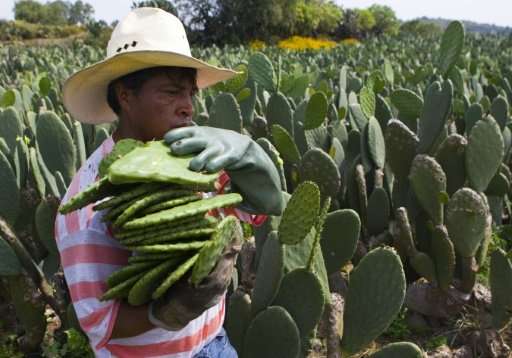UN dishes up prickly pear cactus in answer to food security

The prickly pear cactus, considered an essential food in Mexico, could be the answer to much of the world's food security woes, the UN's Food and Agriculture Organisation (FAO) said Thursday.
"While most cacti are inedible, the Opuntia species has much to offer, especially if treated like a crop rather than a weed run wild," the FAO said in a statement.
The UN organisation—which convened a group of experts to study the plant's potential and help farmers and policy makers use it in a more strategic and efficient way—also released a book "on how to exploit the plant's culinary qualities".
The FAO, along with non-profit agriculture group ICARDA, believes the cactus pear could prove lifesaving, highlighting the 2015 Madagascar drought in which the "cactus proved a crucial supply of food, forage and water for local people and their animals".
The cactus was considered sacred by the ancient Aztecs, and modern-day Mexicans eat it, drink it, and even use it in medicines and shampoos.
Instantly recognisable with its jumble of spiny discs—its bright red fruit protruding from them like fat fingers—the prickly pear cactus is farmed on a massive scale in Mexico, where consumption has reached 6.4 kilogrammes (14 pounds) per year, per capita.
It is now also cooked widely in Sicily, and Brazil has more than 500,000 hectares (1.2 million acres) of cactus plantations, mainly for fodder.
The plant is also grown in North Africa and Ethiopia.
Besides its consumption value, the "cactus pear's ability to thrive in arid and dry climates makes it a key player in food security," the FAO said.
"Cactus stores water in its pads, thus providing a botanical well that can provide up to 180 tonnes of water per hectare—enough to sustain five adult cows, a substantial increase over typical rangeland productivity".
And the benefits do not stop there: the cactus improves soil quality, promotes barley plantations and could even, according to preliminary research, help limit emissions of greenhouse gas.
The plant does have some limitations: for example, frost can cause irreversible damage and the plant's growth begins to slow at overly high temperatures.
But the FAO maintains that the good outweighs the bad.
"Climate change and the increasing risks of droughts are strong reasons to upgrade the humble cactus to the status of an essential crop in many areas," said Hans Dreyer, director of FAO's Plant Production and Protection Division.
© 2017 AFP



















